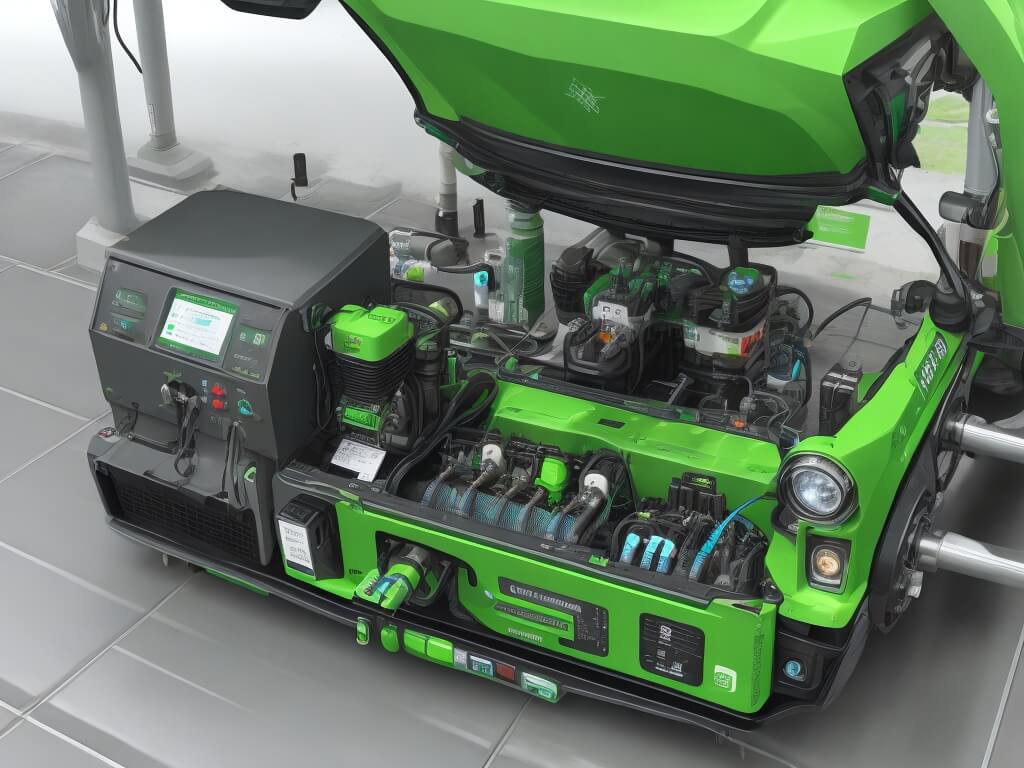
Green hydrogen is a clean and sustainable fuel generated through the process of electrolysis, which involves splitting water molecules into their component elements, hydrogen (H2) and oxygen (O2). What sets green hydrogen apart from traditional hydrogen production methods is its exclusive reliance on electricity obtained from renewable sources such as wind and solar power. This innovative approach ensures that the production of green hydrogen is entirely eco-friendly, as it releases no harmful greenhouse gases into the atmosphere.
The heart of green hydrogen production lies in the electrolysis process, where water (H2O) is subjected to an electric current within a device known as an electrolyzer. During this process, the water molecules are disassembled, resulting in the separation of hydrogen and oxygen. Unlike conventional hydrogen production methods, where fossil fuels are used as a primary energy source, green hydrogen production stands as a beacon of environmental consciousness, contributing to a cleaner and more sustainable energy ecosystem.
The environmental benefits of green hydrogen are significant and undeniable. Its production process ensures that no carbon emissions are released. The more traditional methods of hydrogen production, which typically rely on natural gas or coal, release substantial amounts of carbon dioxide, further emphasizing the importance of green hydrogen as a cleaner and greener alternative.
In addition to its eco-friendly nature, green hydrogen exhibits remarkable versatility, which is a key driving factor behind its growing popularity. This clean energy source can be harnessed across various applications, from fueling vehicles and industrial processes to power generation. Its adaptability makes it an attractive choice for numerous sectors eager to reduce their carbon footprint and transition to sustainable energy solutions.
The Green Hydrogen Production Process
The production process of green hydrogen is a fascinating journey into the world of clean and sustainable energy. It all starts with water, the most abundant resource on our planet. Green hydrogen is created by breaking down water (H2O) into its fundamental elements, hydrogen (H2) and oxygen (O2), through a process known as electrolysis.
Electrolysis takes place within a device aptly named an electrolyzer. This remarkable piece of technology is the heart of green hydrogen production, where water molecules are meticulously separated into their hydrogen and oxygen components. The magic happens when an electric current is applied to water within the electrolyzer, causing the water molecules to split.
What makes this process so special is the source of the electricity used. Unlike conventional hydrogen production methods, which typically rely on fossil fuels, green hydrogen production exclusively utilizes electricity from renewable sources, such as wind or solar power. This key distinction is what sets green hydrogen apart from its conventional counterpart, making it a clean and eco-friendly energy carrier.
By harnessing the power of renewable energy to drive the electrolysis of water, green hydrogen production emits no harmful greenhouse gases. This is a significant step towards a more sustainable and greener future, as it aligns with our collective efforts to combat climate change and reduce our carbon footprint.
The Green Hydrogen Boom
Green hydrogen is currently experiencing a surge in popularity, and it’s not by chance. This remarkable clean energy source is making waves across the globe due to several compelling reasons.
At the forefront of the green hydrogen boom are its remarkable environmental advantages. Unlike traditional hydrogen production methods that heavily rely on fossil fuels, green hydrogen production is a game-changer in the fight against climate change. It stands out by generating zero carbon emissions during its production process. This characteristic positions green hydrogen as a potent tool in our collective effort to reduce greenhouse gas emissions and combat global warming. In stark contrast, the conventional methods of hydrogen production, which primarily use natural gas or coal, release substantial amounts of carbon dioxide, emphasizing the critical role of green hydrogen in providing a cleaner and greener alternative.
Green hydrogen’s adaptability is unparalleled. It is not limited to a single niche but can be harnessed in a diverse array of applications. From powering vehicles with fuel cells to enhancing industrial processes and even acting as a source of clean power generation, green hydrogen showcases its incredible flexibility. This adaptability makes it a highly attractive choice for a wide range of sectors that are keen on reducing their carbon footprint. By offering a clean and efficient alternative to conventional energy sources, green hydrogen is poised to revolutionize multiple industries and contribute to a more sustainable future.
One of the most exciting features of green hydrogen is its capacity for energy storage. It serves as an ideal medium for storing surplus renewable energy, efficiently bridging the gap between energy production and consumption. By converting excess wind or solar energy into hydrogen, we can effectively store and transport this energy over long distances. This storage capability addresses a significant challenge associated with renewable energy sources, which can be intermittent in nature. Green hydrogen serves as a vital component of the solution by allowing for the preservation and transport of clean energy, thereby improving the reliability and stability of the energy grid.
Applications of Green Hydrogen
Green hydrogen is revolutionizing the automotive industry, primarily through hydrogen fuel cell vehicles. These vehicles are gaining traction due to their ability to produce zero emissions, making them an environmentally friendly choice. What’s more, green hydrogen-powered vehicles offer an extended driving range compared to electric vehicles, which is particularly appealing for long-distance travel. They represent a promising solution to reduce carbon emissions in the transportation sector, addressing the pressing need to transition towards cleaner mobility options.
Industries that heavily rely on high-temperature processes, such as steel and cement production, are discovering the advantages of green hydrogen. By substituting fossil fuels with green hydrogen, these industries can significantly reduce their emissions. This transition aligns with their commitment to a cleaner and more sustainable future, while also contributing to the broader effort to combat climate change. Green hydrogen serves as a versatile and eco-friendly energy source that can revolutionize various industrial applications.
The utilization of hydrogen fuel cells to generate electricity is gaining prominence. This application is especially important in regions with intermittent renewable energy sources, such as wind and solar power. Green hydrogen acts as a reliable and clean backup power supply, ensuring the stability and sustainability of the energy grid. It enables a seamless transition towards a more environmentally conscious and resilient energy system.
The Road to a Greener Future
Green hydrogen represents an exciting step toward a sustainable and greener future. Its ability to decarbonize various sectors, coupled with its vast potential for energy storage and transportation, makes it a promising energy carrier. As technology advances and economies of scale are realized, green hydrogen will become an integral part of the global effort to combat climate change.
Green hydrogen offers a cleaner, greener, and more sustainable alternative to conventional hydrogen production methods. With ongoing research and development, this renewable energy source has the potential to revolutionize our world, providing us with a brighter and more eco-friendly future.

